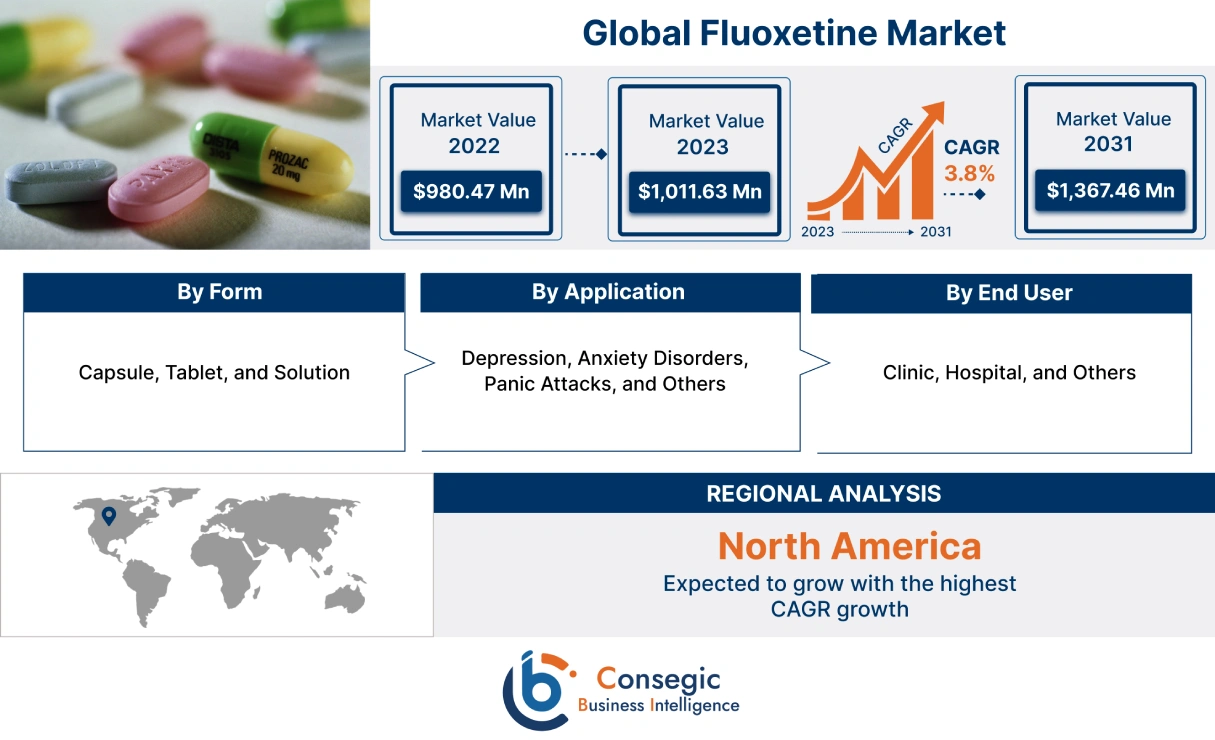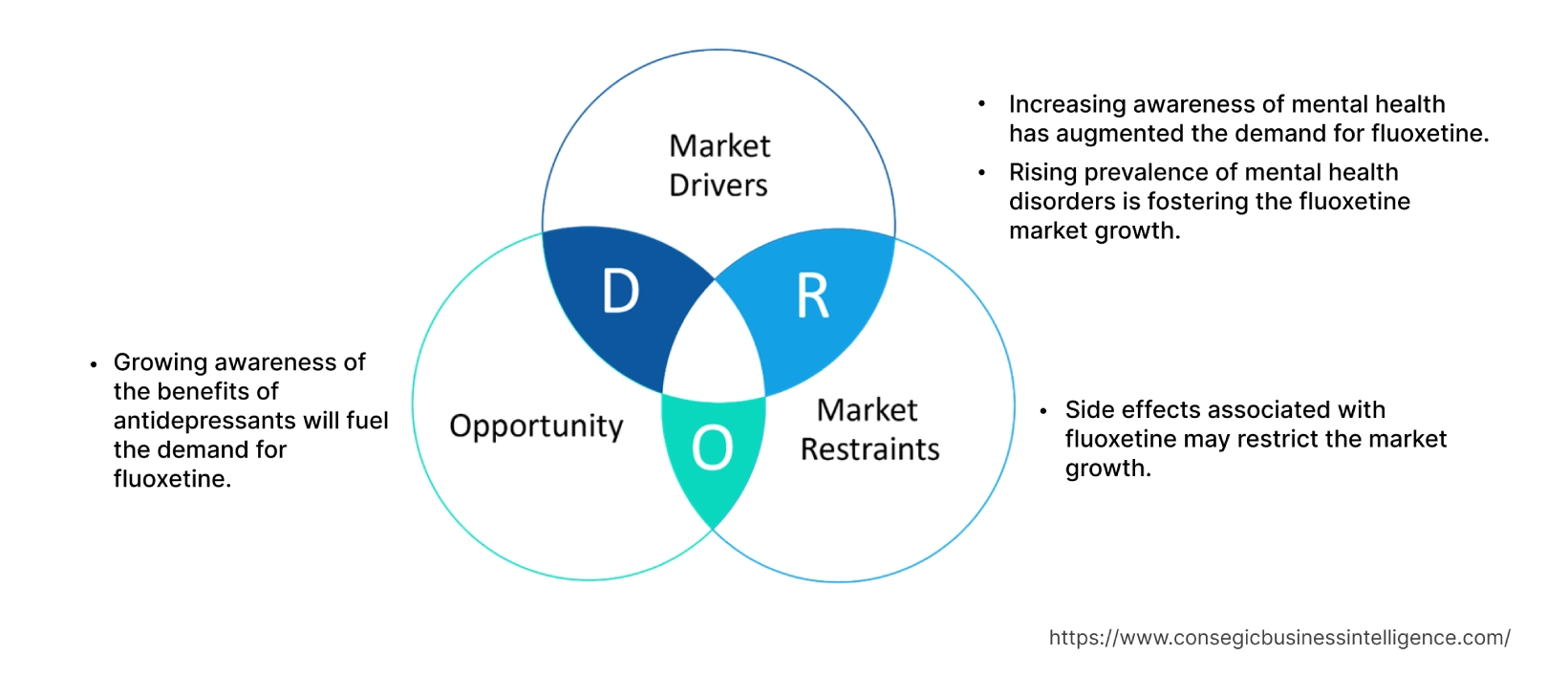Fluoxetine Market Size :
Consegic Business Intelligence analyzes that the fluoxetine market size is growing with a CAGR of 3.8% during the forecast period (2023-2031), and the market is projected to be valued at USD 1,367.46 Million by 2031 and USD 1,011.63 Million in 2023 from USD 980.47 Million in 2022.
Fluoxetine Market Scope & Overview:
Fluoxetine is a selective serotonin reuptake inhibitor (SSRI) antidepressant. This drug is a prescription medicine used for the treatment of a variety of mental health conditions such as depressive disorders, obsessive-compulsive disorder (OCD), bulimia nervosa, panic disorders, and others.
Fluoxetine works by increasing the levels of serotonin in the brain. Serotonin and norepinephrine, both biological amines, have been shown to play a role in depression. Serotonin is a neurotransmitter that plays a role in mood, sleep, appetite, and other functions. By increasing serotonin levels, fluoxetine can help to improve mood, sleep, and reduce anxiety.
Fluoxetine Market Insights :
Fluoxetine Market Dynamics - (DRO) :
Key Drivers :
Increasing awareness of mental health has augmented the demand for fluoxetine
Fluoxetine, a selective serotonin reuptake inhibitor (SSRI) antidepressant, is used to treat a variety of mental health conditions, including depression, anxiety, and obsessive-compulsive disorder (OCD). In recent years, there has been a growing awareness of mental health issues and the importance of seeking treatment. This has led to an increase in the diagnosis of mental health disorders and the prescription of fluoxetine.
Further, mental health campaigns have played a major role in educating the public about the signs and symptoms of mental illness and the importance of seeking treatment. In addition to this, social media has also played a role in increasing awareness of mental health. Hence, growing implementation of interventions focussing on early recognition, mental health promotion and raising awareness about available treatment methods. As a result, the aforementioned factors are accelerating the demand for fluoxetine, in turn propelling the market growth.
Rising prevalence of mental health disorders is fostering the fluoxetine market growth
Fluoxetine works by blocking the reabsorption of serotonin in the brain, which increases the levels of serotonin available. Serotonin is a neurotransmitter that plays a role in mood, sleep, and appetite. As a result, fluoxetine is an effective treatment for a variety of mental health disorders, and it is generally well-tolerated.
Mental health disorders are associated with significant distress, impairment in functioning, or risk of self-harm. According to the World Health Organisation (WHO), mental health conditions are increasing worldwide. For instance, in 2020, the number of people living with anxiety and depressive disorders rose significantly due to the COVID-19 pandemic. Initial estimates accounted for a 26% and 28% increase respectively for anxiety and major depressive disorders from the previous year.
Key Restraints :
Side effects associated with fluoxetine may restrict the market growth
Most common side effects reported by fluoxetine include nausea, diarrhea, insomnia, and sexual dysfunction. These side effects can be a significant market restraint, as they can lead to patients discontinuing treatment. To address the issue of the aforementioned side effects, pharmaceutical companies are developing new antidepressants with fewer and less severe side effects. This is another prominent factor that could hamper the demand for fluoxetine.
Future Opportunities :
Growing awareness of the benefits of antidepressants will fuel the demand for fluoxetine
Antidepressants are a type of medication used to treat depression and other mental health conditions. They work by increasing the levels of certain neurotransmitters in the brain, such as serotonin and norepinephrine. These neurotransmitters are thought to play a role in mood regulation. The growing awareness of the benefits of antidepressants is due to a number of factors, including rise in public awareness campaigns, increasing prevalence of depression, and others. For instance, according to the report published by the American Psychiatric Association, one-third of women are expected to experience a major depressive episode in their lifetime. Additionally, the increasing availability of information related to mental health has created an awareness among the population about the benefits of antidepressants. Hence, the aforementioned factors will aid to surge the demand for fluoxetine in the following years.
Fluoxetine Market Report Insights :
| Report Attributes | Report Details |
| Study Timeline | 2017-2031 |
| Market Size in 2031 | USD 1,367.46 Million |
| CAGR (2023-2031) | 3.8% |
| By Form | Capsule, Tablet, and Solution |
| By Application | Depression, Anxiety Disorders, Panic Attacks, and Others |
| By End User | Clinic, Hospital, and Others |
| By Region | North America, Europe, Asia-Pacific, Latin America, and Middle East & Africa |
| Key Players | Aurobindo Pharma, Alembic Pharmaceuticals Limited, Cadila Pharmaceuticals, Teva Pharmaceuticals USA, Inc., Par Pharmaceutical, Dr. Reddy's Laboratories Limited, Lannett, Sun Pharmaceutical Industries Ltd., Alvogen, Eli Lilly and Company, Accord Healthcare, and Lupin Pharmaceuticals, Inc. |
Fluoxetine Market Segmental Analysis :
By Form :
On the basis of form, the market is segmented into capsule, tablet, and solution. In 2022, the capsule segment accounted for the highest market share of 52.50% and is also expected to grow at the fastest CAGR in the fluoxetine market. The segment growth is attributed to the increasing demand for fluoxetine in oral form due to the convenience and ease of use. Furthermore, the rising prevalence of depression and other mental health disorders is one of the major factors propelling the demand for fluoxetine capsules. For instance, according to the report published by Mental Health America, in 2022, 19.86% of adults in the United States experienced a mental illness. Hence, the aforementioned factors will also accelerate the fluoxetine market growth over the forecast period.
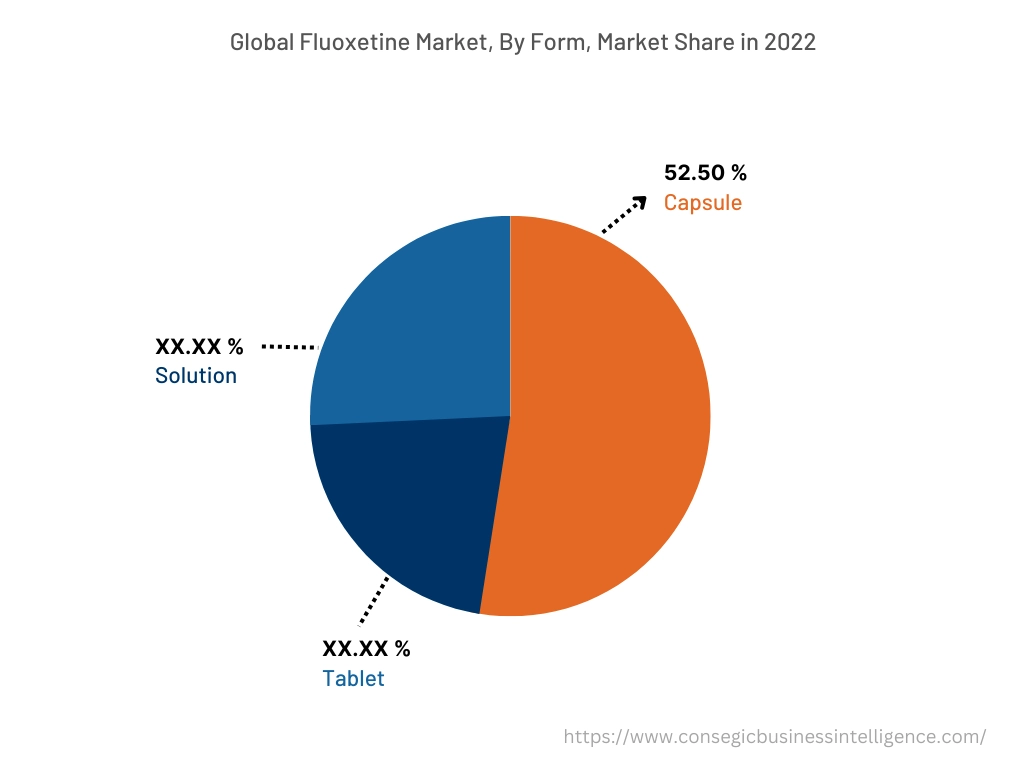
By Application :
On the basis of application, the market is categorized into depression, anxiety disorders, panic attacks, and others. In 2022, the depression segment accounted for the highest market share in the fluoxetine market. The rising prevalence of depression is attributed to a number of factors, including stress, social isolation, and economic instability. For instance, according to the report published by the World Health Organization (WHO), depressive disorder, also known as depression, is the most common mental disorder. In addition to this, more than 700 000 people die due to suicide every year. Suicide is the fourth leading cause of death in 15–29-year-olds.
However, the anxiety disorders segment is expected to grow at the fastest CAGR in the fluoxetine market. Anxiety disorders include panic attacks, specific phobia, and others. According to the statistics published by the National Alliance on Mental Illness, approximately 19.1% of U.S. adults are experiencing anxiety disorders. The key factor driving the segment growth is the rising awareness of the benefits of treatment for panic attacks. This is due to public awareness campaigns and the increasing availability of information about mental health.
By End-User :
Based on end user, the market is categorized into clinic, hospital, and others. In 2022, the clinics segment accounted for the highest market share and is also expected to grow at the fastest CAGR in the fluoxetine market. Clinics are outpatient facilities for non-emergency care. Mental health clinics offer a variety of services, including therapy, medication management, and support groups. Moreover, the increasing number of patients seeking help will bolster the demand for fluoxetine as a treatment option, in turn accelerating the market growth.
By Region :
The regional segment includes North America, Europe, Asia Pacific, Middle East and Africa, and Latin America.
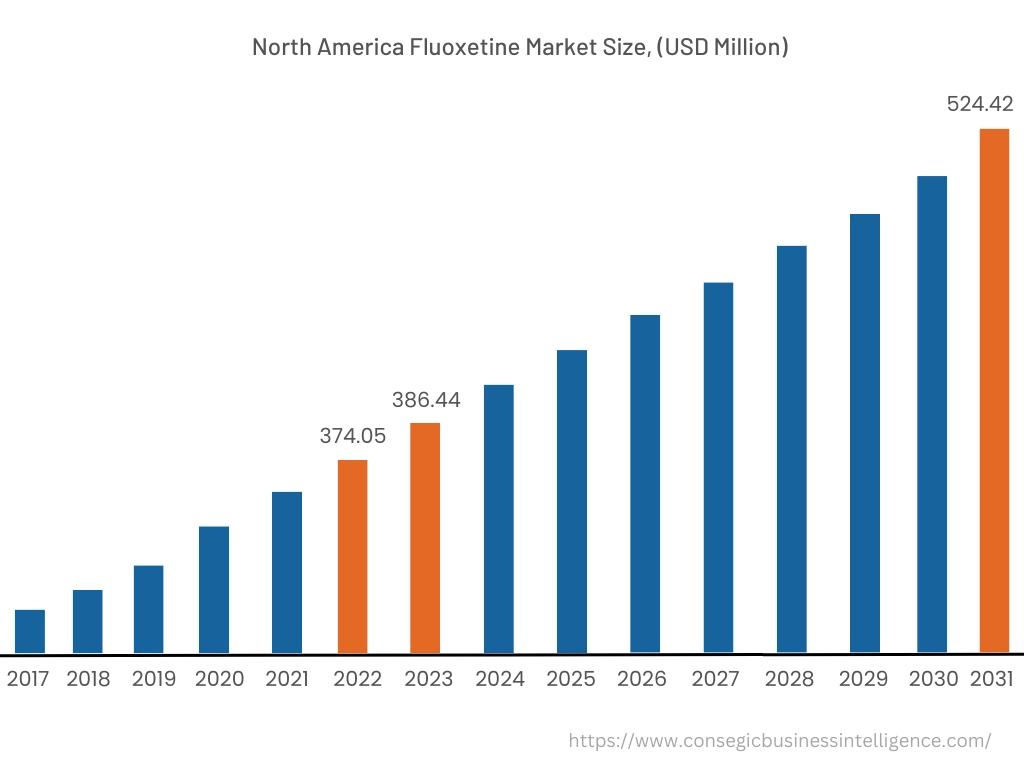
In 2022, North America accounted for the highest market share of 38.15% and was valued at USD 374.05 million in 2022 and is expected to reach USD 386.44 million in 2023 and USD 524.42 million in 2031. In the North American region, the U.S. accounted for the highest market share of 66.30% during the base year 2022. The market growth is attributed to factors such as the increasing prevalence of mental health disorders, the large number of mental healthcare treatment facilities, and more. In addition to this, the COVID-19 pandemic has had a significant impact on mental health, leading to an increase in depression, anxiety, and other mental health problems. Furthermore, according to the statistics reported by the U.S. Department of Health & Human Services, more than 1 in 5 U.S. adults live with a mental illness.
However, Asia Pacific is expected to grow at the fastest CAGR of 4.2% during the forecast period. The growth in the region is driven by factors such as increasing economic inequality and, a rise in age-related mental health disorders, such as dementia and depression. For instance, China has introduced mental health laws, resulting in more facilities, an increase in mental health professionals, and more awareness. According to the article published by the World Health Organization (WHO), nearly 54 million people suffer from depression, and about 41 million suffer from anxiety disorders, in China.
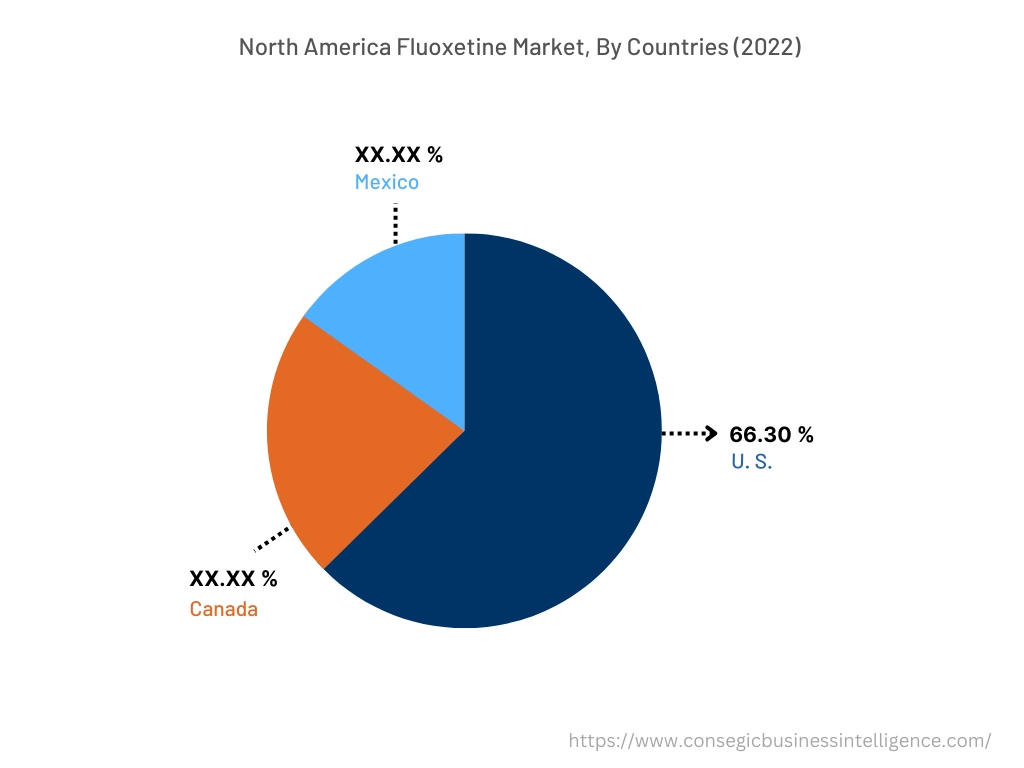
Top Key Players & Market Share Insights:
The fluoxetine market is highly competitive, with several large players and numerous small and medium-sized enterprises. These companies have strong research and development capabilities and a strong presence in the market through their extensive product portfolios and distribution networks. The market is characterized by intense competition, with companies focusing on expanding their product offerings and increasing their market share through mergers, acquisitions, and partnerships. The key players in the market include-
- Aurobindo Pharma
- Alembic Pharmaceuticals Limited
- Alvogen
- Eli Lilly and Company
- Accord Healthcare
- Lupin Pharmaceuticals, Inc.
- Cadila Pharmaceuticals
- Teva Pharmaceuticals USA, Inc.
- Par Pharmaceutical
- Dr. Reddy's Laboratories Limited
- Lannett
- Sun Pharmaceutical Industries Ltd.
Recent Industry Developments :
- In April 2021, FDA approved the fluoxetine oral solution commercialized by Lannett.
- In February 2019, Lupin Pharmaceuticals, Inc. received FDA approval for Fluoxetine Tablets USP to market a generic version of Alvogen Fluoxetine Tablets, 60mg.
Key Questions Answered in the Report
What was the market size of the fluoxetine market in 2022? +
In 2022, the market size of fluoxetine was USD 980.47 million
What will be the potential market valuation for the fluoxetine market by 2031? +
In 2031, the market size of fluoxetine is expected to reach USD 1,367.46 million.
What are the key factors driving the growth of the fluoxetine market? +
The increasing prevalence of mental health disorders has surged the demand for fluoxetine.
What is the dominating segment in the fluoxetine market by application? +
In 2022, the depression segment accounted for the highest market share in the overall fluoxetine market.
Based on current market trends and future predictions, which geographical region will have the fastest impact on the fluoxetine market's growth in the coming years? +
Asia Pacific is expected to be the fastest-growing region in the market during the forecast period.
